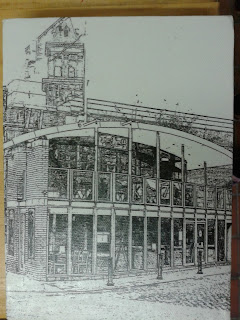A practice run with the images to make sure the spacing is
correct. Hopefully I have achieved as
close a Golden Ratio, as I have spent weeks working out various
measurements. It's hard to tell how the overall effect is going to look not being able to see the stamp images properly.
It has taken me ages deciding how far from the edge of the
middle section I wanted the images to sit.
Here are the first two of seven images glued into place. No turning back now. Now that the canvas is upright you can see the textured tissue paper.
A close up. The colour looks a bit pale here, but is deeper
in reality. I'm excited to see how the tissue is going to look once the washes have been added.
Well on the way now.
I have to say that either I'm getting a bit pedantic over the
measurements or I'm just crap at it, because it took the best part of a whole
afternoon getting it right. I kept having to check it and mark lightly with a charcoal pencil where I wanted the images to sit. I used charcoal because I knew it would wipe away and leave no marks.
I'm liking what I've done so far, but I think I may need to
blend some of the colour to the edges of the photos because I'm not sure about
the clean straight edges of the images.
I know that the stamp edges will blend quite well. All the textures are showing on this image.
Almost there! I can't
wait to start painting the outer edges.
Close
up. I think the photos look good against
the texture and colour. I feel that the photographs are complimented by the background texture and colour, although the yellow ochre may need toning down a little.
All the images on now.
Just waiting for the image transfers to dry so I can rub the backing
paper off. That's a job for tomorrow.
Close up. Although the white paper looks like it is slightly raised it is stuck securely to the surface of the canvas.
At last, some more painting.
I lifted the canvas up in various directions so that the acrylic paints
(yellow and red ochre and burnt sienna) bled into one another to create a more
realistic effect.
I like the colours on this image, but I know I'll need to
knock back the brightness of the yellow ochre so that it looks less garish.
I realised that after looking at this image I needed to add
some red ochre to the top of the textured tissue paper, so that the colours
flowed better. The red ochre adds warmth
to the canvas. I will be adding a paynes
grey wash to the corners at the top edges of the arches to cool the edges
slightly, which should add a little more depth.
It's
starting to take shape by this stage.
Above is a close up of the right hand side of the canvas.
Final section covered.
I will need to wait until it's dry to assess how much work I need to do
to finish the surface. I've not been
able to stand the canvas up yet as the paint is still quite wet.
Looking at this image I realise I will have to add a wash of
paynes grey or red ochre to knock the brightness of the yellow ochre.
One of the things I wanted to achieve was to emphasise the
edges and I think I've succeeded. I may
add some more definition subtly.
Looking up the canvas as it was drying.
Above is a close up showing the textures and definitions of
the edges I spoke about on the previous photo.
Opposite is a slightly larger view.
I think the egg shell looks good with a few more layers of red ochre.
View from the bottom left hand side of the canvas. It's strange how different the colours can
look from a different angle. This corner
looks darker than the previous two images, but in reality it's not.
Top left hand corner close up. I have decided to keep the outer corners very
light to add to the colour contrasts.
This is a form of chiaroscuro that artists such as Turner, Rembrandt and
Caravaggio used to great effect.
I have called this image Reawakening, because Castlefield
was once the hub of Manchester's Industrial economy and with the rejuvenation
of the area into a bustling place, I thought it was an apt name. One of my successful stamp image
transfers. Unfortunately I didn't have
the same success with my photograph image transfers and I've had to make
changes to rectify this development. I
had had the images printed on 160gsm paper using a different printer than I
normally use, but when it came to rubbing the backing paper off, the image was
coming off too. I've had to use images
on printer paper from an inkjet printer.
Let's hope they work this time.

I chose to name this one Revival. It is built into one of the railway arches,
reviving a space that had become redundant.
This too is a success. First I
flipped the image on Photoshop so that it would face the right way. I applied gel medium to the image and placed
it face down onto the canvas. I
burnished the images with a tissue to make sure all the image was completely
flat and secure.
This stamp image is called Renewal, because the area that
the church overlooks has been renewed.
The old mills in Castlefield have been turned into luxury apartments or
offices. Parts of the surrounding area
in Castlefield look fresh and new, yet they don't look out of place with the
Victorian buildings and other feature from that period.
















































